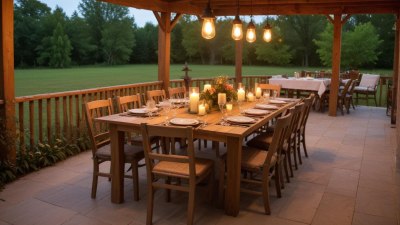Why Outdoor Dining Always Feels Like a Good Idea Until the Wind Shows Up
Explore the allure of outdoor dining and the challenges wind brings to the experience.

This image was created with the assistance of Freepik
Outdoor dining is a cherished experience for many, offering an opportunity to enjoy culinary delights in a fresh air setting. Whether it's a quaint café on a bustling street, a beachside restaurant, or a rooftop bar overlooking a city skyline, the concept of dining al fresco holds an irresistible appeal. The feel of the sun on your skin, the sound of birds chirping, or the gentle rustle of leaves often create an ambiance that indoor dining simply cannot replicate. However, this idyllic scenario can quickly unravel when the wind shows up, turning a pleasant meal into a chaotic endeavor. This article explores why outdoor dining feels like a good idea until the wind rolls in, examining both the charm and the challenges that accompany open-air eating.
The Allure of Outdoor Dining
There’s something inherently romantic about outdoor dining. It's often associated with relaxation and pleasure, enhancing the flavors of the meal while setting a tone of leisure. When we think of dining outside, images of long brunches filled with laughter, casual dinner parties under the stars, and refreshing lunches amidst vibrant flowers come to mind. Outdoor dining fosters a sense of community; tables filled with friends and family create an inviting atmosphere where conversation flows as freely as the drinks. It’s a sensory experience—smelling the fresh scents of nature, feeling the warmth of the sun, and witnessing the beauty of the changing seasons. Moreover, the choices of venues where one can dine outdoors are vast—there are parks, terraces, and gardens available all offering their unique environments. This versatility makes the option of dining outside seem appealing at almost any time of year.
The Dining Experience Amplified
Dining outside amplifies the overall experience. Many establishments take the opportunity to enhance their outdoor spaces, utilizing aesthetics that include twinkling fairy lights, colorful umbrellas, and comfortable seating arrangements, which sociologically invite patrons to linger longer. Tasty food and drinks complemented by a picturesque environment can uplift a meal from the ordinary to the extraordinary. A glass of wine on a cool evening under the stars or a morning coffee amidst a flower-filled garden adds layers to the dining experience that indoor restaurants struggle to achieve. The outdoor scene is dynamic; it changes with the time of day and the seasons, making every dining experience unique.
Seasonal Factors
Outdoor dining is highly seasonal. During warmer months, when the weather is inviting, outdoor dining often feels like a necessity rather than a luxury. The sun shines, patios are alive with laughter, and it's advisable to soak up as much vitamin D as possible. However, while the summer months beckon diners, one needs to consider that the weather can shift dramatically, and that’s where wind becomes a crucial factor. A calm sunny day can quickly turn blustery, taking a serene outdoor meal and tossing it into disarray. Diners might find their napkins become airborne guests, and gusts of wind can send silverware sliding off tables. In worst-case scenarios, diners have had their meals disrupted by loose items flying around, leaving the charming experience eaten away by discomfort.
Wind Challenges
Wind can sap away the tranquility of outdoor dining at any given moment. In addition to blowing napkins and quirky twists of conversation as diners playfully chase their belongings, the wind also impacts the temperature. An outdoor dining experience can become chilling in mere moments as a cool breeze sweeps through, making it hard to enjoy the meal. Restaurants often try to remedy this with outdoor heaters; however, those heaters can fall short during high gusts. Furthermore, the wind can also change the flavor of the dining experience—literally! It can carry unwanted odors or insects that distract from the meal.
The Practical Implications
Understanding the difficulties wind brings to outdoor dining can help potential diners come prepared. Outdoor dining is never truly a risk-free venture, especially in cities known for unpredictable weather patterns. Those dining al fresco should consider choosing restaurants with certain protective features such as umbrellas or canopies that shield the diners from the elements. It’s also wise to check weather apps and forecasts prior to heading out, ensuring that the likelihood of a windy day doesn’t ruin the anticipated meal. Additionally, patrons can bring light jackets or layers in the event of a sudden temperature drop, preparing themselves for changing conditions. Diners can also choose their seating intelligently; positioning themselves either at the restaurant's periphery or in more sheltered areas can make a difference.
Restaurant Preparations
From the perspective of restaurant owners, managing outdoor dining comes with the responsibility of ensuring a pleasant experience for patrons. This may include opting for high-quality outdoor furniture that stays secure despite wind gusts. Heavy planters can serve as barriers between diners and the elements while creating an aesthetically pleasing environment. Restaurants may also consider windbreaks like transparent screens or canvas dividers that provide comfort without obstructing views. Ensuring ample weight on tablecloths and décor can prevent unsightly movement of items on the table. Additionally, menu choices during windy seasons can be adapted to provide more suitable options; lighter plates that don't easily tip or spill may find their way onto the table less frequently.
Addressing the Problem with Innovation
The challenges posed by outdoor dining and wind have sparked innovation within the food and beverage industry. Restaurant owners are seeking innovative solutions to help mitigate the challenges that wind presents. In some advanced locations, restaurants are deploying smart technology to monitor weather patterns in a bid to ensure diners have the best experience possible. With retractable walls and automatic canopies, they can open or close outdoor spaces based on weather conditions. While this technological advancement doesn't entirely banish wind from the equation, it does empower business owners to pivot quickly to protect both customers and the dining experience. Additionally, the use of lighter meats, tacos, wraps, and other portable meals can work well in instances when winds pick up, providing a dining experience that’s still enjoyable, even when nature intervenes.
In conclusion, dining outdoors is undoubtedly a delightful experience that many cherish for various reasons including community, atmosphere, and fresh air. The picturesque scenes and vibrant settings add flavor beyond the culinary delights within the meal, highlighting the social aspect of sharing food. However, no one can deny the sometimes turbulent arrival of wind can dampen a sunny day out. While it’s perhaps unrealistic to think that dining outdoors can ever be entirely devoid of challenges posed by nature, understanding the dynamics involved prepares diners for all eventualities. As we continue to seek joy in outdoor experiences, the balance between savoring the beauty of open-air dining and seeking comfort from the whims of wind remains the challenge—a challenge that, despite its complexities, adds to the mesmerizing appeal of dining outside.











